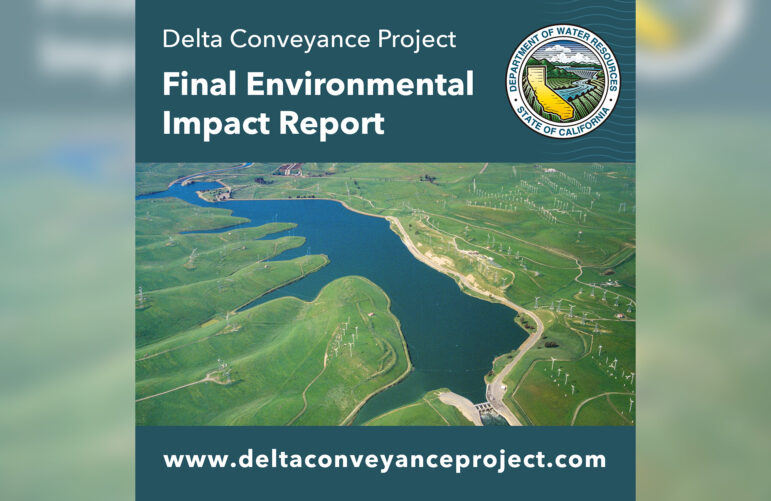The Sierra Club isn’t resting on its laurels.
On Jan. 16, the environmental advocacy group handed the California Department of Water Resources a stunning defeat when a state court judge kiboshed the revenue bond financing for DWR’s plan to use a massive tunnel to divert water from the Sacramento-San Joaquin Delta.
Then on Friday, the Sierra Club, joined by 11 other environmental organizations, filed a new suit in Sacramento County Superior Court, alleging that DWR’s approval of the project violated the California Environmental Quality Act — commonly referred to as CEQA — because the agency did not fully and properly evaluate the environmental impacts of the project on the Delta ecosystem.
Both matters are aimed at blocking what DWR calls the “Delta Conveyance Plan.” The plan is a colossal public project that would divert fresh water flowing into and through the Delta by using an enormous tunnel — 36 feet wide, 45 miles long, and between 140 and 170 feet below ground — to take waterflow from north of the Delta and run it to pumping stations in the south Delta for further transport to southern parts of the state.

The project would use two intakes in the north Delta with the capacity to capture 6,000 cubic feet of water — roughly the capacity of 2.5 medium-sized backyard swimming pools — every second of the year. According to the Sierra Club, the intakes would have the capacity to divert a third of the waterflow of the Sacramento River at the point of intake.
The general purpose of the Delta project is to more efficiently move “surplus” waters from the northern part of California to the south, where 80% of the state’s consumption occurs. Currently much of the excess water comes out of the Sierra Nevada, flows into and through the Delta, and then into aqueducts that carry the water south.
DWR touts the project as a badly needed modernization of the state’s water supply system. Key benefits it identifies are capturing more water during wet seasons, minimizing water loss from evaporation and “protecting against earthquakes disrupting water supplies.”
DWR officials in an explanation accompanying the final environmental impact report for the project said that by 2040, California is expected to lose 10% of its water supply due to hotter temperatures. During last January’s atmospheric rivers, the project could have captured enough water for 2.3 million people to use annually, the department said.
DWR went on to quote Gov. Gavin Newsom, who said, “Climate change is threatening our access to clean drinking water, diminishing future supplies for millions of Californians — doing nothing is not an option … This project is essential to updating our water system for millions of Californians.”
According to the plaintiffs, the project would divert “freshwater flows that presently contribute to water quality, water supply, fish, fish habitat, Delta agriculture, and public health … [in] the lower Sacramento River, sloughs, and Delta.” The project allegedly would cause “increased salinity levels, reduced food supply, increased harmful algal blooms, harm to endangered and threatened fish species, and adverse modification of their designated critical habitat.”
The Sierra Club proposed that DWR consider a variety of alternative approaches to the project, including relying on increased conservation, improved soil management for agricultural uses, and repeal of irrigation subsidies that encourage farms to grow unsustainable crops.
The plaintiffs are not the only opponents of the project. U.S. Rep. John Garamendi, D-Walnut Grove, is committed to the defeat of the project, which he calls a “multibillion-dollar boondoggle.”
“As I told the six previous governors and now Governor Newsom, this tunnel will never be built,” said Garamendi in a statement earlier this month.
“Tunneling under the Delta to export more water to Southern California risks collapsing the Delta’s earthen levees and inundating this iconic working landscape with saltwater.”
Another opponent is San Francisco Baykeeper, an environmental group focusing on water quality in the San Francisco Bay, and five other environmental and tribal groups who have filed a separate lawsuit. Like the Sierra Club’s suit, the action challenges DWR’s compliance with CEQA and asks the court to set aside the approval of the project.
In a 66-page complaint filed Monday in the same court as the Sierra Club action, the plaintiffs point to a long list of deficiencies in DWR’s environmental impact report and in the project. They conclude that “the Project will have terrible consequences on fish, wildlife, and the Delta’s aquatic ecosystem, including for the threatened and endangered species present in the Delta and in the San Francisco Bay (that rely on the Delta), including Chinook Salmon, Delta Smelt, Longfin Smelt, Central Valley Steelhead, and others.”
The Sierra Club’s new suit comes on the heels of a Jan. 16 decision by Judge Kenneth Mennemeier of Sacramento County Superior Court (the same court in which Friday’s suit was filed) that DWR had exceeded the authority delegated to the agency by the Legislature when it defined the project to be financed by the $16 billion bond issue. That meant that the court could not “validate” the bonds that would have financed the project. Validation is a critical step in the issuance of revenue bonds and their marketing in public markets.
When asked why the new suit was necessary in light of the result in the earlier case, John Buse, one of the plaintiffs’ lawyers in the new case, said, “the state will do everything it can to reverse the financing decision, so we can’t be sure how that will end. Regardless of how it ends, however, we needed to challenge the environmental report, or the Department of Water Resources could rely on it with impunity in the future.”
Bob Wright, another lawyer for the plaintiffs in the new case, sees the issue from the perspective of governmental accountability. Wright said, “the purpose of the lawsuit is to require DWR to tell the truth about the project’s severe adverse impacts.”
